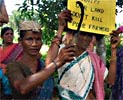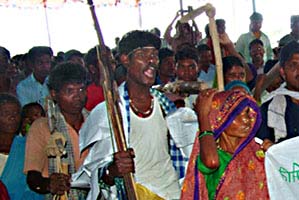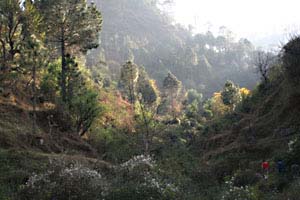Shimla Declaration
Himalayan People's Conclave on Climate Justice
Uttarakhand Center
October 2009 ministers of the Himalayan states came together in Shimla to discuss global warming issues. 200 activists of 30 civil environment groups organised a parallel meeting and published 'The Shimla Declaration'. They criticise the hypocrisy of the state governments which are talking about combating global warming and at the same time enhance this dangerous development by constructing many dams, thermal power stations and cement factories.
The declaration states: "The mountain people have traditionally lived a low energy, low consumption, and low waste life styles. It is
very important to learn from these, and emulate this in a larger scale in view of the necessity of reducing the global emission
of green house gasses."
Open Letter to the Chief Ministers of Himalayan States
some fragments
Kalibari, Shimla, 30th October, 2009
Climate change has emerged as one of the most hotly debated and significant issues of the current times. While this phenomenon effects temperature and rainfall patterns across the world, some areas are being impacted more severely than others. Himalaya, which provides life-sustaining 'eco-system services' to a large part of south-Asia, is one such region. While the impacts of climate change on the Himalayan ecosystems like accelerated glacial melt and distorted rainfall patterns have been studied in depth, preparation to tackle these impacts, both at the national and state levels are seem to lack vision and are generally based upon the same paradigm of unsustainable development that has brought this world to the current state of crisis.
While the Chief Ministers of Himalayan states meet in Shimla to adopt a common strategy to combat climate change, their development policies are contradicting the very reason that has brought them together - that issues within the unique and critically important Himalayan ecosystems need unique solutions. Whereas the Himalayan Chief Ministers are likely to demand enhanced financial allocation for their states on account of preserving green cover, their policies on the ground are critically contributing to undermining the green cover. We would like to bring the following facts to your notice:
* Large scale hydropower has been promoted across the Himalayas in a manner most insensitive to local livelihoods and natural resources. Throughout
the Himalayas, thousands of large and small hydroelectric projects are either planned, operational or under execution. While the reservoir type projects
contribute to climate change through deforestation and methane emission, the run of the river projects result in raising ambient temperatures (and loss of
moisture-in-the-air needed by plants), due to drying up of river beds for long stretches, at times up to 40 Kms.
* Scaling-up of so-called run of the river projects, with consequent dams and large and long tunnels running under whole villages, forests and pastures, are
causing destruction of homes, habitats and life support systems, draining off precious ground water and increased risks of earthquake damages.
* The effects of climate change, in the shape of reduced availability of stream/river flow, is going to deny essential water for irrigation, when mini hydro
plants on these same streams/rivers get government backing in preference to peoples' 'rights' to this water, leading to more violent conflicts in the coming
years.
* The government is promoting extractive and climate impacting industry like cement, mining and industrial scale manufacture in big way. In Himachal
alone, three cement industries are already operational and one more shall soon start production. Besides these, at least four major cement mining
and processing plants are in various stages of establishment, which according to reports by government departments are going to adversely impact
local water supply and rich agriculture. One of these mines and plants at Shikridhar is unbelievably proposed to be situated between two high Himalayan
mountain ranges, the Dhauladhars and Pir Panjal. The thousands of tons of coal to be burnt in these plants, the thousands of trucks that would ply to
transport the raw material and cement, resulting in large amounts of air-warming aerosols and dark particle deposition on glaciers, as well as the
associated deforestation would further accelerate glacial melt.
* The government is also promoting power guzzling industry like steel processing in the industrial belts. This creates an additional burden
on the state to provide them power during the winter months when the Himalayan states are already short of power. Power cuts have now become
frequent in the industrial zones; as a solution to which the industry, through tacit backing of the government, is pushing the case for establishment
of many captive thermal power plants.
The Shimla Declaration gives another seven problem points. Then it gives eleven positive suggestions. Here we quote four:
* Local solutions to generate extra energy like biogas and efficient wood stoves should be promoted in a big way. Biogas not only reduces
methane emission from bio-waste, but also promotes sequestration of carbon by improving land productivity.
* All efforts must be made to promote community control and management of natural and new forests through user group level institutions that
are based on democracy and social-economic equity. This would not only enhance the available livelihoods base to adapt to climate change, but
also contribute by creating viable carbon sinks.
* Mainstream livelihoods development by using appropriate technology for job generation should be based upon the local natural resources such
as diverse farming, livelihoods based forestry, horticulture, fruit and vegetable processing, rural tourism, handicraft, animal husbandry,
aquaculture, mushroom growing, bee keeping etc. Monocultures and commercial species that do not support local livelihoods are vulnerable to
catching fire and exist extensively in the sub tropical regions. They should be converted into mixed livelihood supporting forests through
peoples' institutions.
* The mountain people have traditionally lived a low energy, low consumption, and low waste life styles. It is very important to learn from
these, and emulate this in a larger scale in view of the necessity of reducing the global emission of green house gasses. It is imperative that
local communities be involved in decision making of all plans/programs/projects through democratic and transparent institutions, with the right
to informed choice.
Go to next page: overview photo series dams, tunnels
or to: Overview articles and photos about resistance in Uttarakhand Center





